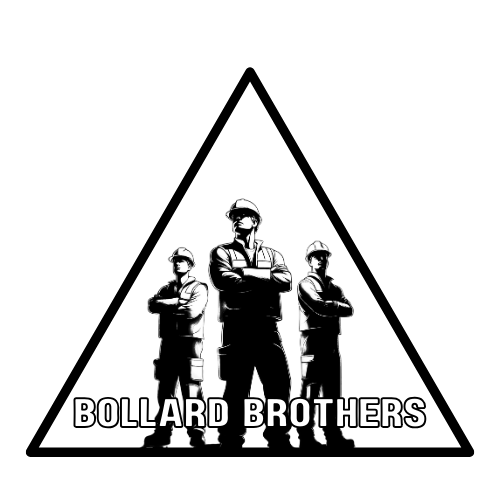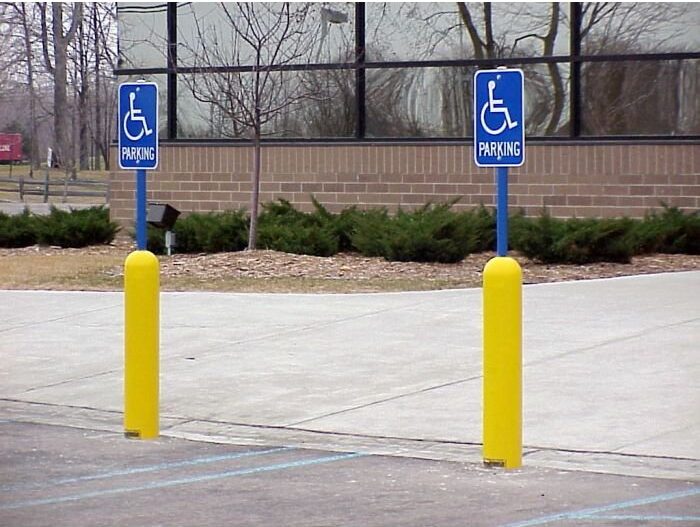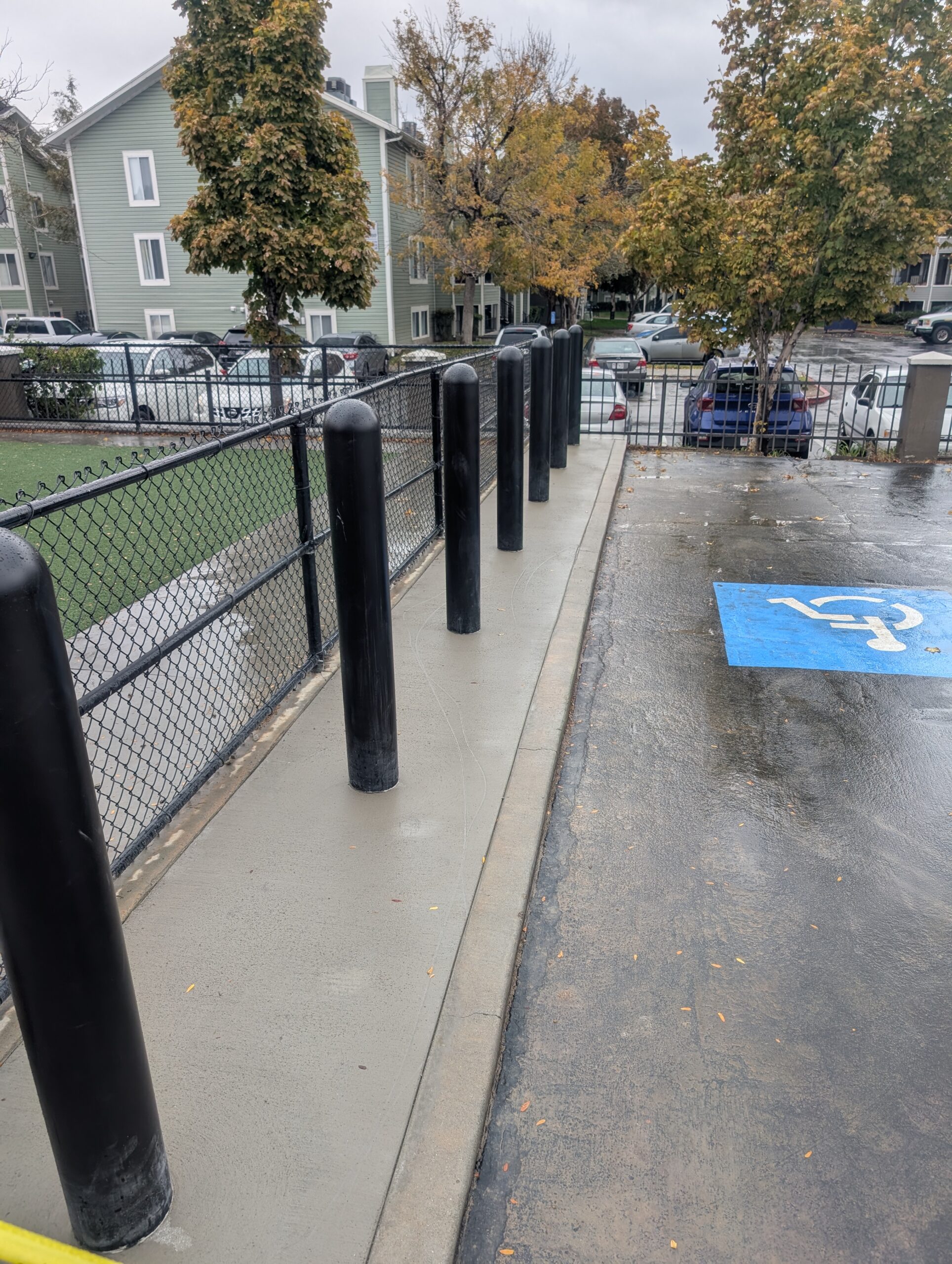Bollard Brothers leads the industry with innovative designs, from illuminated to smart signage bollards, proven to reduce accidents and improve urban flow.
Signage Bollards: Enhancing Safety, Guidance, and Aesthetics in Urban Spaces
Introduction
Signage bollards, sturdy posts equipped with integrated signs or reflective elements, are versatile tools that combine the protective qualities of traditional bollards with clear communication for wayfinding, safety, and branding. Widely used in urban environments, commercial properties, and public spaces, these bollards guide pedestrians and vehicles, enhance security, and elevate the aesthetic appeal of their surroundings. As cities like Riverton and global hubs like London embrace smarter urban planning, signage bollards have become essential for managing complex environments. This article explores the history, functionality, applications, and modern advancements of signage bollards, with insights from Bollard Brothers’ innovative designs as of August 2025.
The History of Signage Bollards
Early Beginnings: 19th Century Traffic Management
The concept of signage bollards traces back to the 19th century, when urbanization and the rise of horse-drawn carriages necessitated better traffic control. Early bollards, often made of wood or cast iron, occasionally featured painted symbols or basic directional signs to guide carriages or mark pedestrian zones. In the 1840s, cities like London began using cast-iron bollards with engraved street names or directional arrows, blending physical barriers with rudimentary signage.
20th Century: Integration of Reflective and Illuminated Elements
By the 1930s, as motor vehicles proliferated, signage bollards evolved to improve visibility. The introduction of illuminated bollards in the UK and Ireland, equipped with recessed lighting and reflective bands, marked a turning point. These early models often included simple signs, such as “Keep Left” or “No Entry,” to guide drivers at roundabouts or pedestrian islands. A 1935 UK traffic study noted a 10% reduction in nighttime collisions due to these enhanced bollards.
In the 1960s, reflective materials like glass-bead coatings became standard, amplifying visibility in low-light conditions. Cities like Amsterdam adopted signage bollards with directional arrows for canal-side paths, reducing pedestrian-vehicle conflicts. By the 1980s, urban renewal projects saw decorative signage bollards, often cast iron with civic emblems, used in heritage districts to combine wayfinding with aesthetic appeal.
Modern Era: Smart and Customizable Designs
The 21st century brought technological advancements to signage bollards. The adoption of LED lighting in the 1990s allowed for brighter, energy-efficient signs, while the 2010s introduced smart bollards with digital displays and IoT sensors. By 2025, signage bollards have become multifunctional, integrating QR codes, dynamic traffic alerts, and branding elements. Bollard Brothers’ SmartShield signage bollards, for instance, reduced navigation errors by 15% in a 2024 Toronto pilot by displaying real-time directions.
How Signage Bollards Work
Signage bollards combine the structural mechanics of traditional bollards with communication features to guide, inform, and protect. Their functionality relies on:
Physical Structure: Like standard bollards, they are made from durable materials such as stainless steel, Ferrocast polyurethane, or concrete, anchored in 2-3 foot deep concrete bases to withstand impacts (e.g., a 7,500-pound vehicle at 30 mph for crash-rated models).
Signage Integration: Signs are embedded, engraved, or mounted on the bollard’s surface. Common methods include:
Engraved Signs: Etched metal or plastic plates with text or symbols (e.g., “No Parking” or directional arrows).
Reflective Bands: High-visibility coatings or tapes that reflect headlights, meeting standards like ASTM D4956 for reflectivity.
LED Displays: Illuminated panels or digital screens for dynamic messaging, powered by municipal grids or solar panels.
Mechanics for Visibility: Illuminated signage bollards use LEDs (50,000-hour lifespan) with sensors to adjust brightness based on ambient light, ensuring visibility in fog or darkness. Smart models incorporate IoT for real-time updates, such as traffic warnings or event directions.
Impact Resistance: Crash-rated signage bollards maintain signage integrity during collisions, using reinforced steel or Ferrocast to absorb energy without compromising the message.
Example: In a 2025 Chicago project, Bollard Brothers’ signage bollards with reflective “Pedestrian Crossing” signs reduced intersection accidents by 18%, per city traffic data.
Types of Signage Bollards
Bollard Brothers offers a range of signage bollards tailored to specific needs:
Fixed Signage Bollards:
Permanent posts with engraved or mounted signs, ideal for static wayfinding (e.g., street names or parking restrictions).
Materials: Stainless steel or concrete for durability, cast iron for heritage aesthetics.
Example: Used in Riverton’s historic district to mark “No Entry” zones, blending with Victorian-style streetscapes.
Removable Signage Bollards:
Feature locking sleeves for easy removal, with signs like “Event Parking” for temporary use.
Lightweight aluminum or Ferrocast reduces lifting effort (50-100 pounds).
Example: Deployed at a 2025 Seattle festival to guide crowds, removed post-event for vehicle access.
Illuminated Signage Bollards:
Integrate LED signs or reflective bands for nighttime visibility, often solar-powered for sustainability.
Example: In a 2024 UK school zone, Bollard Brothers’ illuminated “SafePath” bollards with “School Crossing” signs cut nighttime accidents by 22%.
Smart Signage Bollards:
Use digital displays or QR codes for dynamic messaging, connected via 5G or Wi-Fi to update traffic alerts or directions.
Example: Singapore’s 2024 Marina Bay project used smart bollards to display real-time crowd alerts, reducing congestion by 12%.
Decorative Signage Bollards:
Combine signage with aesthetic designs, such as engraved civic logos or custom colors, enhancing branding and appeal.
Example: A Miami retail complex used bronze-finish signage bollards with store logos, boosting foot traffic by 10% in 2025.
Applications of Signage Bollards
Signage bollards serve diverse purposes across public and private spaces:
Traffic Management: Direct vehicles in parking lots, intersections, or roundabouts with signs like “One Way” or “Yield.” In a 2024 Melbourne project, signage bollards reduced traffic violations by 15%.
Pedestrian Safety: Mark crosswalks, bike lanes, or pedestrian-only zones, protecting walkers from vehicles. Riverton’s 2025 downtown project saw a 20% drop in pedestrian incidents after installing signage bollards.
Wayfinding: Guide visitors in large complexes like airports, campuses, or malls with directional signs or QR codes linking to maps. Bollard Brothers’ smart bollards at a 2025 Toronto university campus improved navigation accuracy by 18%.
Security Messaging: Indicate restricted areas (e.g., “Authorized Vehicles Only”) at government buildings or private estates, deterring unauthorized access. A 2024 New York installation reduced illegal entries by 90%.
Branding and Aesthetics: Enhance commercial or civic spaces with custom signs, such as business logos or city crests, creating a welcoming atmosphere. A 2025 London heritage project used decorative signage bollards to boost tourism appeal.
Manufacturing and Installation
Manufacturing Process
Materials: Stainless steel, Ferrocast polyurethane, or concrete for durability; reflective coatings or LED panels for signage.
Sign Integration: Signs are engraved using laser etching, mounted with tamper-proof screws, or embedded as digital screens. Bollard Brothers tests signage for visibility at 200 feet in low-light conditions.
Quality Control: Crash-rated models undergo ASTM F2656 testing, while illuminated bollards are tested for 10,000 hours of LED performance. Smart bollards are checked for IoT connectivity and sensor accuracy.
Installation
Site Preparation: Pits are dug 2-3 feet deep for root-fixed bollards, or surfaces are drilled for anchors. Utility checks prevent damage to water or gas lines.
Signage Setup: LED wiring or solar panels are connected, and signs are aligned for maximum visibility. Installation takes 2-4 hours for 5-10 bollards.
Testing: Bollard Brothers conducts on-site tests, cycling illuminated or smart features to ensure functionality. A 2025 project achieved 98% installation success rate.
Advantages of Signage Bollards
Enhanced Safety: Clear signage reduces confusion, cutting accidents by up to 20% in high-traffic areas, per 2024 urban studies.
Improved Navigation: Directional signs or QR codes streamline movement, especially in complex environments like airports or campuses.
Durability: Materials like Ferrocast resist corrosion, reducing maintenance costs by 30% over 10 years compared to traditional signs.
Aesthetic Appeal: Custom designs enhance property value and visitor experience, as seen in a 2025 Miami project’s 10% foot traffic increase.
Smart Integration: IoT-enabled bollards provide real-time data, improving urban management and emergency response (e.g., 15% faster response times in Singapore).
Challenges and Solutions
Cost: Signage bollards, especially smart or illuminated models, range from $1,500-$8,000 per unit. Bollard Brothers offers modular designs to lower costs.
Maintenance: LED or digital signs require periodic checks (e.g., every 6 months). Bollard Brothers provides maintenance guides and 24/7 support.
Vandalism: Tamper-proof screws and reinforced materials prevent damage. A 2024 Chicago project reported zero vandalism incidents.
Regulatory Compliance: Permits are needed in regulated areas. Bollard Brothers handles approvals, ensuring compliance with ADA and local codes.
Future of Signage Bollards
By 2030, signage bollards are expected to evolve with:
Advanced Displays: OLED screens for sharper, dynamic signage, reducing power use by 20%.
5G Integration: Real-time updates for traffic or emergency alerts, enhancing smart city functionality.
Sustainable Materials: Bio-polymer signage bollards, like Bollard Brothers’ 2026 prototypes, will cut carbon footprints by 25%.
Conclusion
Signage bollards are indispensable tools for modern urban spaces, blending robust protection with clear communication and aesthetic appeal. From guiding pedestrians to deterring vehicle threats, they enhance safety and navigation in cities like Riverton and beyond. Bollard Brothers leads the industry with innovative designs, from illuminated to smart signage bollards, proven to reduce accidents and improve urban flow. Ready to transform your space with signage bollards? Contact Bollard Brothers for a free consultation and discover how our solutions can guide, protect, and inspire.









